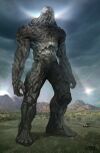الأساطير الصومالية
 |
| جزء من سلسلة عن |
| ثقافة الصومال |
|---|
| الثقافة |
| الشعب |
| الدين |
| اللغات |
| السياسة |
الأساطير الصومالية تغطي the beliefs, myths, legends and folk tales circulating in Somali society that were passed down to new generations in a timeline spanning several millennia. Many of the things that constitute Somali mythology today are traditions whose accuracy have faded away with time or have transformed considerably with the coming of Islam to the Horn of Africa.
The culture of venerating saints and the survival of several religious offices in modern Somalia show that old traditions of the region's ancient past had a significant impact on Islam and Somali literature in later centuries. Similarly, practitioners of traditional Somali medicine and astronomy also adhere to remnants of an old cultural belief system that once flourished in Somalia and the wider Horn region.
قبل الإسلام

The Somali people in pre-Islamic times are believed to have adhered to a complex belief system, with a set of deities superseded by a single all-powerful figure called Eebbe/waaqale (God, also known in Oromo as Waaq). Religious temples dating from antiquity known as Taallo were the centers where important ceremonies were held led by a Wadaad priest. Waaq was a pre-Islamic Sky God associated with rain, fertility, sacred trees, crow, peace and harmony, it is construed in Somali with words like Bar waaqo ("living happily") , Ceel Waaq (a town's name) and Cabu Waaq (a clan name).[1][2]
الآلهة
| Waaq
(إله) |
Waaq is the ancient Cushitic Sky God more specific to many tribes Waaq.[3][4][5] This is not a specific Somali name perse and according to Somali Legend Eebbe lived in the Heavens and whenever the nomads successfully prayed for rain, They would seek his indulgence. Words like Barwaaqo (Living Happily).[6][7] |
| Ayaanle (Angels) | The Ayaanle in Ancient Somalia were known as the good spirits and acted as mediators between God and humans. They were said to be bringers of luck and blessings. |
| Huur (Reaper) | Huur was the messenger of Death and had the form of a large bird. The deity was akin to Horus of ancient Egypt and played a similar role in Somali society. |
| Nidar (Punisher) | Nidar was the righter of wrong. He was considered the champion of those that were exploited by their fellow humans. The deity has survived in modern Somalia as a popular saying; Nidar Ba Ku Heli ("Nidar will find and punish the ones who are naughty"). |
| Wagar | A sacred wooden sculpture associated with fertility.[8] |
الملوك والملكات والقديسون الأسطوريون
In Somali mythology, there is an abundance of tales about men and women who defied cultural traditions or acquired heroic and saintly status amongst the masses of the Somali Peninsula.
| Amel Ali (ملكة) | Amel Ali was a legendary queen in ancient Somalia who is said to be the fastest woman in her time. |
| Wiilwaal (ملك) | Wiil Waal was a legendary king in ancient Somalia known for his bravery and skills in battle. |
| Bucur Bacayr (ملك) | Bucur Bacayr was a legendary king of the Yibirs in Somaliland. |
Arraweelo (Queen) Queen Arraweelo was a legendary queen, who empowered women's rights, by making them stop their 'womanly' duties, which made the men realise their need for women.
العمالقة والعفاريت
| حباد في كاماس
(عملاق) |
Habbad ina Kamas was a legendary cruel giant who ruled half of ancient Somalia. Habbad oppressive rule was the complete opposite to the kindness and care that was bestowed upon the other half of the land ruled by the giant Biriir ina Barqo. He was eventually defeated and slain in battle by Biriir, when the latter found out about Habbad's tyranny. |
| Biriir ina Barqo
(عملاق) |
Biriir ina Barqo was a legendary heroic giant in ancient Somalia known for his just rule and kindness. He lived in a cave called Shimbiraale (the cave of birds) and used to wear a heavy ring that no man could lift. He answered the pleas of those suffering under the rule of the giant called Habbad and defeated him in battle. He then united the two lands and ushered in a long period of peace.[9] |
| Qori-ismaris ("One who rubs himself with a stick") | Qori-ismaris was a man who could transform himself into a "Hyena-man" by rubbing himself with a magic stick at nightfall and by repeating this process could return to his human state before dawn.[10] |
| Dhegdheer ('"One with long ears") | Dhegdheer was a female cannibalistic demon who hunted in Somali forests. Her victims were usually wandering or lost children. |
| Buuti (shape-shifting human/creature) | Buuti was one of the children of Dhegdheer who risked her life to save the innocent villagers. She turned heroic when she saved the people but was forever cursed to be shape-shifting cannibalistic creature. |
| Fadumo iyo Farax (The surviving children of Buuti) | Fadumo iyo Farax successfully pass the seven trials and survived the chase of their cannibalistic mother after finding she murdered their father and little sibling. Fadumo iyo Faraxlived isolated life until Fadumo married off as she was never to return. |
| Coowlay Jajab (continued story of Fadumo iyo Farax) | Farax prayed to have his sister back or be turned into a tree to wait until she comes back since he was of old age so his prayed was answered he was cursed to be tree for years. One day his sister comes back with her family. The children would cut the trees leaf and Farax response "abti eeda" - After Fadumo children keep telling her she cut a leaf and he responded . She made prayer to reverse the curse and they united. |
الأماكن الأسطورية
Many regions of Somalia have cities or specific areas whose names corroborate the stories told in Somali mythology. Waaq in itself is a Somali word and are used to name places such as Abudwaaq ("Worshiper of God"), Ceel Waaq ("Well of God"), waaq-ooyi("north God") and other similar towns with the name Waaq in it suggest a relation to the old Waaq worship practiced in the Horn. The Tomb of Arawelo is another popular mythological place in Somalia said to be the final resting place of Queen Arawelo. In modern times, it is considered an important place for Somali women.
| Mythology |
|---|
المراجع
- ^ Mukhtar, Mohamed Haji (2003-02-25). Historical Dictionary of Somalia (in الإنجليزية). Scarecrow Press. ISBN 978-0-8108-6604-1.
- ^ Fioupou, Christiane (2000). Seuils: Les Littératures Africaines Anglophones (in الإنجليزية). Presses Univ. du Mirail. ISBN 978-2-85816-505-6.
- ^ Levine, Donald N. (2014-12-10). Greater Ethiopia: The Evolution of a Multiethnic Society (in الإنجليزية). University of Chicago Press. ISBN 978-0-226-22967-6.
- ^ Mire, Sada (2020-02-05). Divine Fertility: The Continuity in Transformation of an Ideology of Sacred Kinship in Northeast Africa (in الإنجليزية). Routledge. ISBN 978-0-429-76924-5.
- ^ Wainwright, G. A. (2011-06-09). The Sky-Religion in Egypt: Its Antiquity and Effects (in الإنجليزية). Cambridge University Press. ISBN 978-0-521-23751-2.
- ^ Thomas, Douglas; Alanamu, Temilola (2018-12-31). African Religions: Beliefs and Practices through History (in الإنجليزية). ABC-CLIO. ISBN 978-1-61069-752-1.
- ^ Abdullahi, Mohamed Diriye (2001). Culture and Customs of Somalia (in الإنجليزية). Greenwood Publishing Group. p. 65. ISBN 978-0-313-31333-2.
waaq.
- ^ Mire, Sada (2015-03-01). "Wagar, Fertility and Phallic Stelae: Cushitic Sky-God Belief and the Site of Saint Aw-Barkhadle, Somaliland". African Archaeological Review (in الإنجليزية). 32 (1): 93–109. doi:10.1007/s10437-015-9181-z. ISSN 1572-9842. S2CID 162114929.
- ^ Folktales from Somalia by Ahmed Artan Hanghe, p. 144.
- ^ Mohamed Diriye Abdullahi (2001). Culture and Customs of Somalia. Culture and Customs of Africa. Greenwood. p. 68. ISBN 9780313313332.
